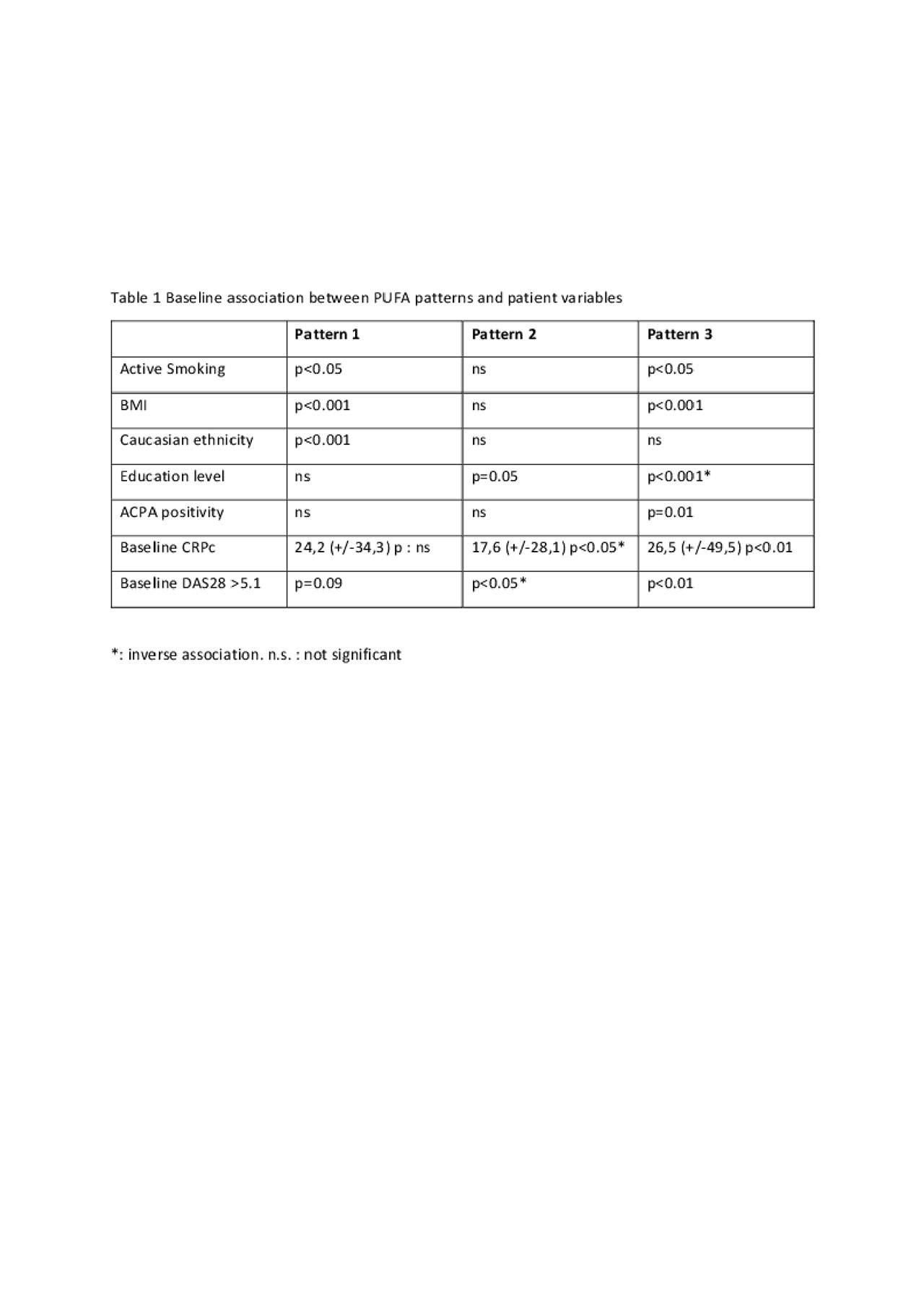Session Information
Date: Sunday, November 10, 2019
Title: RA – Diagnosis, Manifestations, & Outcomes Poster I: Risk Factors, Predictors, & Prognosis
Session Type: Poster Session (Sunday)
Session Time: 9:00AM-11:00AM
Background/Purpose: Long-chain polyunsaturated fatty acids (PUFAs) of the n3 and n6 families can contribute to modulate inflammatory processes. Dietary intake of n3PUFA is inversely associated with the incidence of RA in different populations. In subject at risk of developing RA, a high erythrocyte content in long-chain n3-PUFA is associated with lower ACPA prevalence and less progression to RA. While long-chain n6PUFA are considered mainly proinflammatory, the erythrocyte content in n6 linoleic acid was inversely associated with the development of RA in a nested-case control study. This study aims to characterize serum profiles of PUFA and to determine their association with baseline variables, with 6-month disease activity and 2-year radiographic progression in a cohort of patients with early RA.
Methods: Serum PUFAs were quantified by gas chromatography-mass spectrometry in 594 patients with early RA at recruitment in the French ESPOIR cohort. Cluster analysis on 19 serum fatty acids with 14 to 22 carbon atoms allowed to determine 3 patterns of baseline serum PUFA. Pattern 1 included high proportions of n7 and n9 PUFA, pattern 2 was high in n3 long-chain PUFA (EPA et DHA), pattern 3 was rich in n6 long-chain PUFA. Those patterns were not mutually exclusive (i.e. each patient could fit at different level into different profiles). Patients were stratified in tertiles according to how much the fitted into the pattern (tertile 1 meaning lowest and tertile 3 highest fitting into the pattern). The association of PUFA patterns with baseline variables was tested at univariate analysis. The association with 6-month high disease activity (DAS28 >5.1) was tested at multivariate analysis after adjustment on baseline CRP, corticosteroid and/or NSAIDs, socioeconomic status, ACPA, RF, traditional and biologic DMARDs treatment between 0 and 6 months after inclusion. The same model was used to test the association with 2-year radiographic progression.
Results: At baseline, pattern 1 was associated with high BMI, active smoking and with non-Caucasian origin (table 1). Profile 2 was associated with higher socioeconomic status and inversely associated with DAS28 and CRP. Profile 3 was associated with ACPA positivity and higher baseline CRP. At multivariate analysis, fitting into pattern 2 or 3 was associated with lower odds of having active disease after 6 months (OR for tertile 3 vs. tertile 1: 0.49 (95% CI 0.25 to 0.97, p< 0.05) for pattern 2 and 0.51 (0.28 to 0.95) for pattern 3, respectively). None of the patterns associated with 6-month disease activity was associated with 2-year radiographic progression.
Conclusion: In a cohort of early RA patients, we identified a favorable high serum long-chain n3PUFA profile, associated with low baseline inflammation and persistently low disease activity between 0 and 6 months of follow-up in the cohort. This is consistent with a presumed immunomodulatory action of n3PUFA. Despite a clear baseline association with disease severity features, like ACPA positivity and high CRP, a high serum long-chain n6PUFA profile was also associated with 6-month lower disease activity. Despite the longitudinal association with disease activity, none of the baseline PUFA patterns predicted radiographic progression.

Table 1 Baseline association between PUFA patterns and patient variables
To cite this abstract in AMA style:
Sigaux J, Buscail C, Julia C, Flipo R, Cantagrel A, Bannwarth B, Laporte F, Challal S, Boissier M, Semerano L. Serum Long-chain n-3 and -6 Fatty Acids Are Associated with Disease Feature at Onset and with 6-month Disease Activity in Early RA: Results from the ESPOIR Cohort [abstract]. Arthritis Rheumatol. 2019; 71 (suppl 10). https://acrabstracts.org/abstract/serum-long-chain-n-3-and-6-fatty-acids-are-associated-with-disease-feature-at-onset-and-with-6-month-disease-activity-in-early-ra-results-from-the-espoir-cohort/. Accessed .« Back to 2019 ACR/ARP Annual Meeting
ACR Meeting Abstracts - https://acrabstracts.org/abstract/serum-long-chain-n-3-and-6-fatty-acids-are-associated-with-disease-feature-at-onset-and-with-6-month-disease-activity-in-early-ra-results-from-the-espoir-cohort/
